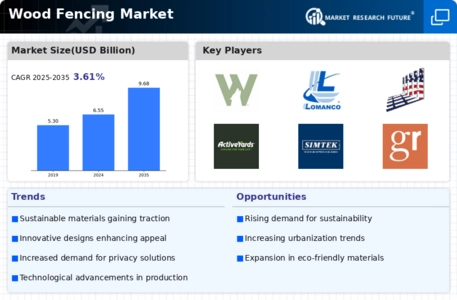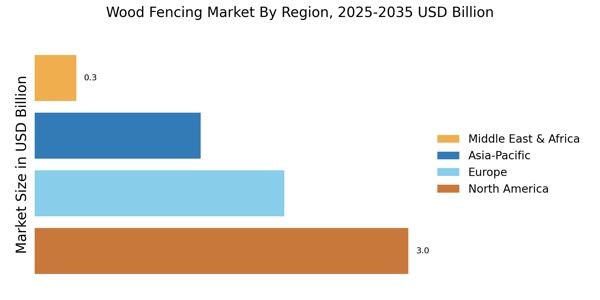Rising Demand for Eco-Friendly Solutions
The Wood Fencing Market experiences a notable increase in demand for eco-friendly solutions. As consumers become more environmentally conscious, the preference for sustainable materials rises. Wood fencing, being a renewable resource, aligns with this trend. In recent years, the market has seen a shift towards responsibly sourced wood, with certifications such as FSC gaining traction. This shift not only caters to consumer preferences but also supports sustainable forestry practices. The market data indicates that the eco-friendly segment of the wood fencing market is projected to grow at a compound annual growth rate of approximately 5% over the next five years. This growth reflects a broader societal movement towards sustainability, positioning the Wood Fencing Market favorably in a competitive landscape.
Rising Interest in Outdoor Living Spaces
The Wood Fencing Market is positively impacted by the rising interest in outdoor living spaces. As homeowners increasingly invest in their backyards and gardens, the demand for attractive and functional fencing solutions grows. Wood fencing is often favored for its natural look and ability to create a sense of privacy and security. Market analysis indicates that the outdoor living segment is expanding, with a projected growth rate of 6% annually. This trend is driven by a desire for outdoor entertainment areas, gardens, and recreational spaces. Consequently, the Wood Fencing Market stands to gain from this shift, as consumers seek to enhance their outdoor environments with aesthetically pleasing and durable fencing options.
Technological Innovations in Wood Treatment
The Wood Fencing Market is witnessing advancements in wood treatment technologies, which enhance the durability and longevity of wood fencing products. Innovations such as pressure treatment and advanced coatings protect wood from environmental factors, thereby increasing its lifespan. These technological improvements not only reduce maintenance costs for consumers but also make wood fencing a more attractive option compared to alternatives. Recent data suggests that treated wood fencing products have seen a price increase of approximately 10% due to their enhanced properties, yet the demand remains strong. This indicates that consumers are willing to invest in higher-quality products, further solidifying the position of the Wood Fencing Market in a competitive market.
Increased Residential Construction Activities
The Wood Fencing Market benefits significantly from the surge in residential construction activities. As urbanization continues to expand, the demand for new homes increases, leading to a higher need for fencing solutions. Recent statistics suggest that residential construction has seen a steady growth rate of around 4% annually, which directly influences the wood fencing market. Homeowners often seek wood fencing for its aesthetic appeal and durability, making it a preferred choice in new developments. Additionally, the trend towards outdoor living spaces further drives the demand for wood fencing, as homeowners look to enhance their properties. This growing construction activity is likely to sustain the Wood Fencing Market's growth trajectory in the coming years.
Growing DIY Culture and Home Improvement Trends
The Wood Fencing Market is significantly influenced by the growing DIY culture and home improvement trends. As more homeowners engage in personalizing their living spaces, the demand for wood fencing solutions rises. DIY projects often include fencing installations, as wood is perceived as a manageable material for home improvement enthusiasts. Market data reveals that the DIY home improvement sector has expanded by approximately 7% annually, with fencing being a popular project among homeowners. This trend not only boosts sales in the wood fencing market but also encourages innovation in product offerings, as manufacturers cater to the needs of DIY consumers. The Wood Fencing Market is likely to continue benefiting from this cultural shift towards self-sufficiency and home enhancement.


















Leave a Comment